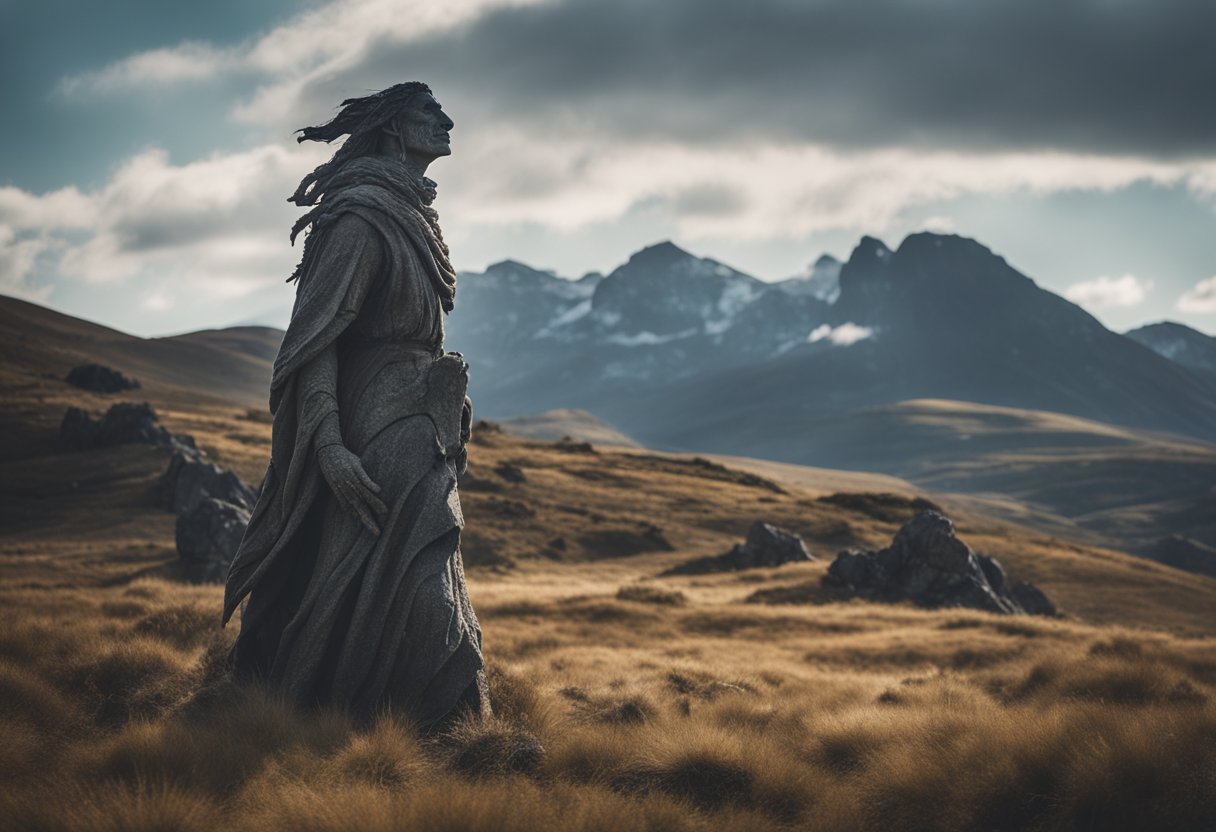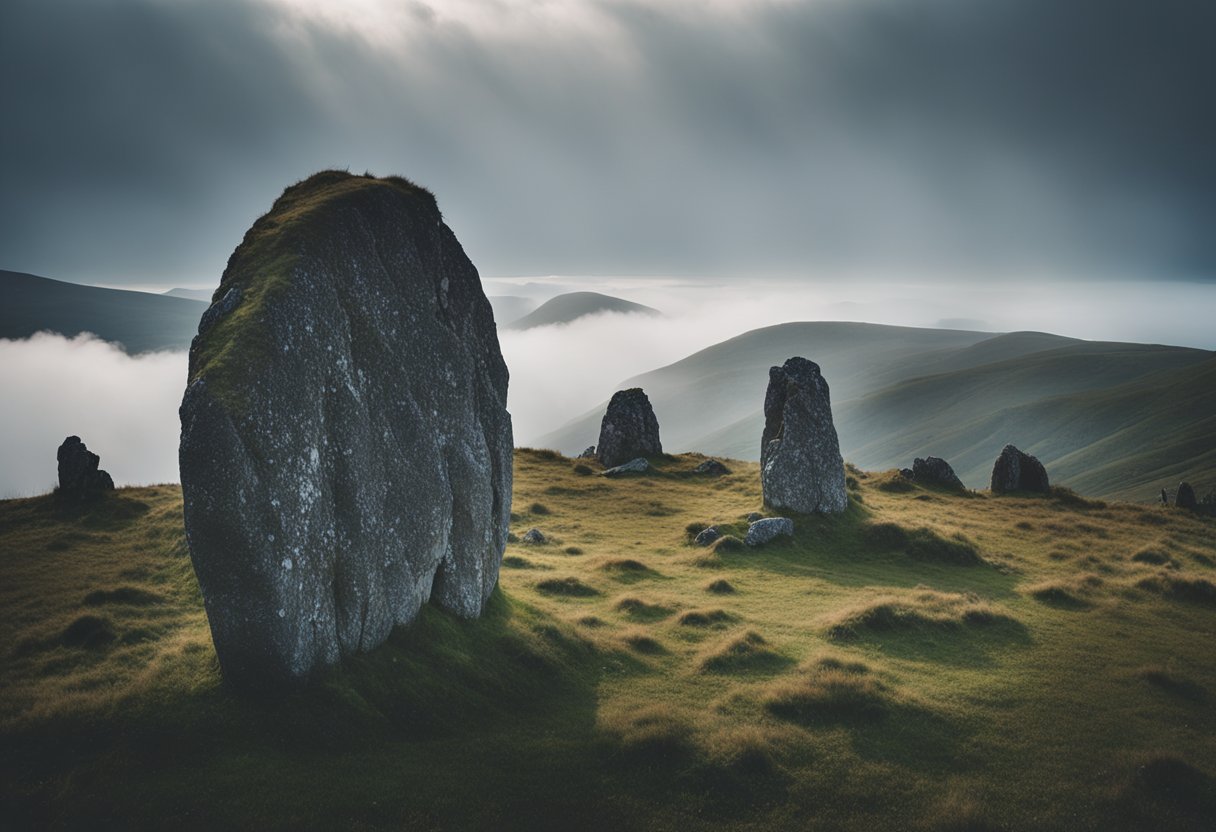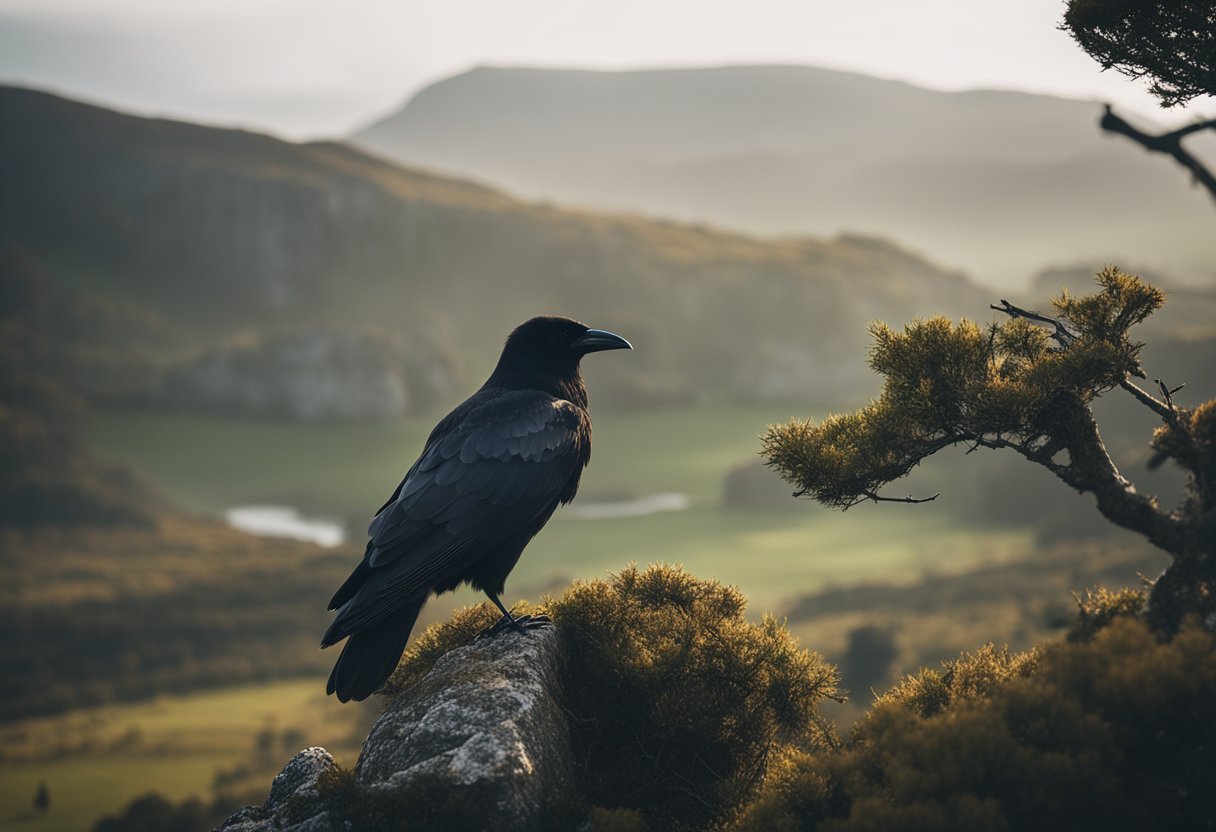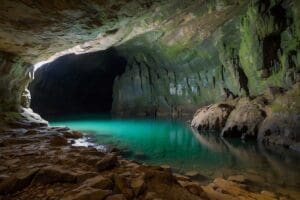The Cailleach: Unveiling the Mystique of Ireland’s Hag Goddess

Updated On: March 17, 2024 by Eman Sameh
Immersed within Celtic mythology, the figure of the Cailleach stands out as a potent emblem of the transformative power of nature and the ancient wisdom of the land. Her name, echoing through the ages, is synonymous with the raw forces of winter and the crone aspect of the Triple Goddess in pagan traditions. The Cailleach is often envisioned as a divine hag, a creatrix, and a weather deity whose moods usher in the seasons, presiding over the cycles of life, death, and rebirth.

Our exploration deepens our understanding of her origins. We trace her influence across the landscapes of Ireland and Scotland, where she is woven into the fabric of folklore and associated with numerous sacred sites. Her presence resonates in the enduring cultural representations and celebrations that pay homage to her legend. The Irish Hag’s narrative extends beyond mere mythology, embodying ecological principles and preserving heritage, revealing her relevance in contemporary society.
The Origins and Evolution of the Cailleach
The Cailleach is an enigmatic figure deeply woven into Celtic mythology. She represents the personification of winter, the harshness of nature, and the forces of creation and destruction. As a deity, this Irish Hag is primarily associated with the landscapes of Ireland, Scotland, and the Isle of Man. Our understanding of the Cailleach has evolved over centuries, with her story echoing through the spoken word and Gaelic literature.
Initially, this Hag was seen as a creator goddess linked with shaping the land. She was said to be the essence of the wilderness, wielding a magical staff that controlled the weather and the seasons. In old tales, this Irish Goddess is often depicted as an ancient hag with profound powers.
- Gaelic Origins: Her name, derived from the Gaelic word for ‘old woman’ or ‘hag’, signifies her role as an elder in the pantheon of Gaelic deities.
- Mythical Roles:
- Ireland: Seen as a sovereign figure over the land, embodying the spirit of the country.
- Scotland: Described as a protector of animals during winter.
- Isle of Man: Known as a personification of winter storms and the harshness of nature.
Throughout Irish and Scottish mythology, the Cailleach’s stories have been passed down through generations, revealing her as an ever-changing symbol of nature’s power. Her lore demonstrates the profound cultural significance and the deep respect our ancestors held for the forces that govern life and the landscape. As a testament to her impact, her name and legend remain rooted in the places she’s said to have touched, with geographical features named after her.
Our recognition of this Hag Goddess today transcends her ancient origins. She offers a timeless connection to the Celtic people’s shared heritage and natural history. She stands as a compelling emblem through which we can explore the mysteries and spirituality of Celtic mythology.
Symbolism and Significance
In this section, we’ll unpack the layers of symbolism that the Cailleach brings to Celtic mythology, from her embodiment of the natural world to her influence over the changing seasons.
The Cailleach in Nature
The Cailleach is deeply woven into the tapestry of the natural world, particularly within the rugged landscapes of Ireland and Scotland. She is often depicted as the personification of winter and death, signalling the end of the life cycle, yet crucially, her presence also makes way for renewal and rebirth come spring. Many tales speak of her connection to mountains, where she is said to use her hammer to shape the valleys and hills, thus etching the land with her might and will.
Reverence in Gaelic Culture
In Gaelic culture, the Cailleach holds a sacred place as a divine figure. She exemplifies nature’s harshness and unforgiving qualities, yet simultaneously, she represents fertility, ensuring that the soil is nourished and ready for new life. Her duality is revered, embodying both the wisdom that comes with age and the necessity of the death-life cycle.
The Cailleach and Seasonal Changes
Attributed with the power to control the weather and seasons, this Irish Hag Goddess is often celebrated and feared for her influence over winter’s onset and departure. As the goddess who transitions the world from the deathly grip of winter back to the life-affirming warmth of spring, her legend encapsulates the balance of life and death that is seen year after year in the recurring flow of the seasons. She is a reminder of the cyclic nature of life and the environment’s deep connection with the cultural understanding of time and change.
Depictions and Descriptions
In exploring the intricate lore surrounding the Cailleach, we uncover the vivid depictions and specific descriptions that paint a portrait of this renowned figure in Irish mythology.
Imagery and Attributes
The Cailleach is traditionally envisioned as a hag or an old woman with a stark connection to the raw forces of nature. She is said to wield formidable power over storms and wind, often depicted with a haunting presence that commands the elements. Her association with wolves, creatures synonymous with the wilderness, highlights her dominion over animals and untamed landscapes.
Attributes of the Cailleach:
- Staff or Hammer: Used to shape the terrain or control the weather.
- Veiled Appearance: Signifying her epithet, the “veiled one.”
- Blue face and fierce eyes: Reflecting her otherworldly nature and crone-like features.
These symbols succinctly capture the essence of her might and her integral role as a deity of winter and wildness.
Transformation into the Hag
The transformation of the Cailleach from a seasonal goddess into the archetypal crone is a significant aspect of her legend. It is believed that at the close of winter, she turns into a large grey boulder or stone, symbolising her enduring nature and permanence in the landscape. This metamorphosis emphasises her cyclical relationship with nature and the passing of time, further reinforcing her as a symbol of both transformation and constancy.
The Cailleach’s transformation tales are steeped in mysticism
- From Goddess to Stone: This transmutation marks the seasonal pivot from the harshness of winter to the rejuvenation of spring.
- Representing Renewal: Her reappearance each year echoes ancient themes of rebirth and continuity.
Our understanding of the Cailleach hinges upon the intricate web of symbolism connected to her representations, providing a window into the ancient Celtic worldview.
The Cailleach in Folklore and Myth
The legend of the Cailleach permeates the folklore of Ireland and Scotland, painting the picture of a powerful deity whose tales crisscross the Gaelic lands. She is a complex figure, intertwined with the natural world and the changing seasons.
Tales Across the Lands
The Cailleach, known as the veiled one, has roots deep in Irish and Scottish mythology. Accounts from Ireland portray her as the Hag Bhéara, while in Scotland, she is referred to as the Cailleach Bheurra. As a shapeshifter, she is often associated with the creation of the landscape, and it is said that the mountains and valleys were formed as she traversed the land. Some tales suggest the Irish Had Goddess, in her aspect as a giant bird, carries boulders in her apron and drops them at will, forming cairns and hills.
The stories of the Cailleach convey her as a being of great immortal strength, embodying the raw forces of nature and the spirit of the land itself. She is often linked with the sovereignty of the land, symbolising the harshness of winter and the life-giving energy of the earth.
Mystical Abilities and Powers
The Cailleach is depicted as holding a wealth of mystical abilities. One of the most potent symbols of her power is the staff, with which she is said to command the weather, ushering in the frosts and snows of winter with a sweep of her hand. Her transformative qualities as a shapeshifter reflect her mastery over the elements and the animal kingdom.
Her powers are also woven with a thread of fear, for she represents the dark and uncultivated aspects of the world, a reminder of the fierce and untameable forces outside human control. Yet, she is also regarded as a goddess of protection and wisdom, a guardian of the balance between civilisation and the wild.
In the weaving of the Cailleach’s tales, we encounter a vibrant tapestry of folklore that resonates with the primordial essence of the goddess and the ancient landscapes she governs.
Geographical Connections and Sacred Sites

The Cailleach is profoundly intertwined with the landscapes of the Celtic nations. Numerous landmarks and natural features bear her mark, highlighting the goddess’s role as a sculptor of the land itself.
Ireland’s Landscapes
The Cailleach is deeply rooted in Ireland’s terrain, particularly evident in the wild and rugged beauty of the Beara Peninsula. Here, the Hag of Beara looms large in local legend as a symbol of enduring strength, visible in the stark cliffs and rock formations that adorn the coast. The Cliffs of Moher in County Clare are another testament to her influence, where the sheer cliffs plunge into the Atlantic, mesmerising visitors with their majestic presence.
Scotland’s Mountains and Valleys
In Scotland, the Cailleach’s essence echoes through the Highlands. In the heart of Argyll and Bute, Ben Cruachan is known as the hollow mountain, and legends speak of this Irish Hag residing there. The landscape offers a tangible connection to the goddess. Further into the heartlands, Glen Lyon in Perthshire carries tales of the Cailleach, where nature’s quietude belies a spiritual depth entwined with the goddess.
The Isle of Man’s Influence
The Manx culture, too, recognises the Cailleach’s role, where she is said to have shaped the island itself. This enigmatic figure’s presence is felt in the deep valleys and rugged coastal cliffs that sculpt the Isle of Man, weaving the essence of the goddess into the very fabric of its landscapes. Our connection to this Irish Goddess here is a testament to the timeless narratives that have been passed down through generations, linking us to these sacred sites.
The sites across these regions, from the Cliffs of Moher and the Beara Peninsula in Ireland, the haunting beauty of Scotland’s Ben Cruachan and Glen Lyon, to the Isle of Man’s evocative landscapes, all stand as powerful symbols of the Cailleach’s enduring legacy.
Cultural Representations and Celebrations

We find that the portrayal and commemoration of the Cailleach are richly woven into the cultural tapestry, reflecting her significance in Gaelic tradition as a potent symbol of the changing seasons.
The Cailleach in Modern Media
The mysterious Cailleach, frequently identified with the Queen of Winter, has penetrated modern media with portrayals that often emphasise her sovereignty over the chill of winter. Our explorations have unveiled depictions in literature and film that resonate with her original mythos, presenting her as a figure both ancient and sacred. She often appears as a guardian of the land, embodying the harshness of nature and the wisdom of age. The intersection of these modern narratives with ancient folklore preserves the essence of Cailleach’s legend, keeping her story alive in the collective consciousness.
Festivals and Rituals
The celebration of the Cailleach is deeply interwoven with Gaelic festivals. Imbolc, in our findings, is especially significant as it traditionally marks the beginning of spring. It is seen by some as the day when the Cailleach gathers her firewood for the rest of the winter – should she wish to make it last longer, she ensures Imbolc is bright and sunny so she can gather plenty. However, our customs contrast this with the adoration of Brigid, the goddess associated with the arrival of spring, to whom this day is dedicated, signifying the Cailleach’s retirement and the subsequent renewal of the land.
The Gaelic festival of Samhain, which marks the end of the harvest season and the onset of the darker half of the year, is yet another period rife with references to the Cailleach. During Samhain, gales sweep the land as the Cailleach’s presence is believed to stir the leaves, her dominion over the waning light evident in the lengthening nights. Samhain, a time for honouring ancestors and forecasting the fortunes of the coming year, aligns with our perception of the Cailleach’s transformative power, marking an end and a new beginning.
Our insights are evidence of how these celebrations and the figure of the Cailleach are sacred cornerstones of Gaelic culture, symbolising the cyclical nature of life, death, and rebirth. Through festivals and media alike, the enduring legacy of the Cailleach is a celebration of both her might and her mystery.
Artifacts and Symbols
We will explore the tangible connections to the Cailleach through the physical representations and tools associated with her legend.
Artistic Renditions
Artistic interpretations of the Cailleach often depict her holding a staff, which she is said to use to strike the ground, bringing forth winter by freezing the earth. Sculptures and paintings may also portray her with a boulder or stone, symbolising her role as a deity of the land often associated with large stones and rocky landscapes. These representations serve to embody the goddess’s connection to the harshness of the wintry season and the ruggedness of the natural world.
Artefacts of Worship
Certain sacred objects reinforce her mythology throughout the regions where the Cailleach is revered. Wells, sometimes perceived as portals to the otherworld in Celtic tradition, are thought to be blessed by the hag goddess and are often visited for their healing properties. Specifically, the Cailleach is linked to the concept of a well of youth, a place where renewing waters are said to flow. It is rare to find tangible artefacts like a hammer, which are thought to represent the Cailleach’s ability to craft and shape the land, but when such items are uncovered, they are held in high esteem as connections to ancient practices of worship.
The Cailleach and Other Deities
In our exploration of the Cailleach, it becomes apparent that she is intricately connected with various Celtic goddesses and exists within a broader tapestry of comparative mythology.
Associations with Celtic Goddesses
The Cailleach is often associated with Brigid, also known as Bride or Brìghde. Both figures occupy dominant positions within the seasons of the Celtic year. The Cailleach rules over the winter months, typically heralded from Samhain until Bealltainn when her reign gives way to Brigid, who brings with her the fertility and warmth of the spring and summer months. This duality reflects the aged Crone aspect of the Cailleach against the youthful Maiden aspect of Brigid, embodying the Mother Goddess archetype that cycles through life, death, and rebirth. These contrasting deities symbolise the sovereignty of nature and the changing seasons, where the Cailleach’s rule is frosted with winter’s chill, and Brigid’s touch heralds growth and fertility.
Comparative Mythology
Within comparative mythology, the Cailleach is seen as a creator and shaper of the landscape. Like figures in other mythologies, she commanded the winds and weather, crafting mountains and valleys with her might. Variations of the Cailleach, like Milucra who sought eternal youth, show the motif of the hag transforming into a maiden, which is found across a variety of world mythologies. This transformative power of the Cailleach reiterates her role as a goddess of sovereignty, not just over the winter realm, but over the power to renew and change the face of the earth itself.
Considering these mythological figures, the parallels with entities like the Bodach arise, an illustration of the complex, interwoven tapestry of Celtic and wider Indo-European mythological traditions. Through such comparative study, the depth of Cailleach’s character as a deity of winter, wind, and wilderness is enriched and becomes more insightful within the context of world mythology.
Legends and Lore in Popular Culture
We find that The Cailleach permeates various aspects of contemporary culture, lending her mythos to literature, film, music, and art. These storytelling mediums revitalise ancient legends, continuing the narrative of the Irish hag goddess in modern times.
Influence on Literature and Film
In literature, The Cailleach often serves as an archetype for characters imbued with ancient wisdom and elements of the earth and winter. Her influence is apparent in characters found in fantasy genres, where the blend of human and supernatural traits aligns with her mythic status. Her story has been creatively adapted, with the Cailleach Bhéara sometimes featuring as a central figure representing themes of transformation and the cyclical nature of life and seasons.
On-screen, films and television series have drawn on her lore, crafting narratives that explore the depth of Celtic mythology. The portrayal of The Cailleach in these visual stories frequently underscores her duality—as the bringer of winter’s harshness and as a protector of the land. These modern interpretations examine the nuances of her legend, translating them into powerful cinematic tales.
The Cailleach in Music and Art
In the realm of music, artists have found inspiration in The Cailleach, composing pieces that evoke the atmosphere of the ancient landscapes she is associated with. Instrumental melodies and vocal performances often reflect the stark beauty and formidable nature of The Cailleach, connecting listeners to the raw emotions of the myths.
Art, too, has been enriched by the image of The Cailleach. Paintings and sculptures have captured her essence, ranging from representations of an aged, wise woman to her transformation into a youthful maiden. Each artistic interpretation invites viewers to consider the enduring impact of myth on our perception of the natural world. The visual language of The Cailleach in modern art resonates with a reverence for the storied past while echoing pop culture’s fascination with her enduring legend.
Conservation of the Legend
In our quest to honour the enduring narrative of the Cailleach, a figure deeply rooted in Irish folklore, we focus on the ongoing efforts to keep this legend alive. The intrinsic value of this myth to Ireland’s cultural heritage propels us to not only recount but also strengthen the preservation of this ancient story.
Preservation of Oral Traditions
The continuity of the Cailleach’s tale, like many traditional legends, relies heavily on the practice of oral history. Scribes and storytellers of past centuries played a crucial role in weaving the narrative thread that has reached our times. Oral traditions, maintained through storytelling iterations, enable the essence of the tale to persist. Kilcatherine, an area in Ireland associated with the goddess, remains a significant location for the Cailleach’s narrative, where local communities actively participate in cultural preservation. By recounting the Cailleach’s story, they uphold a sense of heritage and ensure its passage to future generations.
Role of Historical Societies
Historical societies and heritage groups dedicated to conserving tradition act as stewards of such myths. Their efforts, ranging from oral history projects to the establishment of archives, aim to protect these narratives as part of the collective memory. The guardianship of the Cailleach legend by such societies ensures that this enchanted narrative is not lost to the ages. Through engagement with local communities, detailed record-keeping, and public education, they uphold the tradition and ensure it remains a vibrant part of our heritage.
By embracing these approaches, we foster a deeper connection with our past, and Cailleach’s story continues to be a source of wonder and cultural identity.
Frequently Asked Questions
As we delve into the rich tapestry of Irish mythology, let’s address some common queries regarding one of its most enigmatic figures – the Cailleach.
Who is the Cailleach in Irish mythology?
The Cailleach is depicted as an ancient deity, embodying the harshness of winter and the ruggedness of the landscape. She is revered in Irish, Scottish, and Manx folklore as a powerful figure representing the cycle of life and rebirth.
Can the Cailleach be considered a personification of winter?
Indeed, the Cailleach is often regarded as the very personification of winter. Her presence is associated with the cold, the dying of the foliage, and the onset of the winter season.
How does the Cailleach figure relate to the transformation of the seasons?
Traditionally, the Cailleach is seen to rule the winter months, her dominion ending when spring is brought forth by Brigid, symbolising the natural transition from the decay of winter to the fertility of spring.
What are the main symbols and attributes associated with the Cailleach?
Commonly, the Cailleach is linked with various symbols of winter’s might, including the staff she wields to bring forth frost and the stones she carries that are said to shape the landscape.
In what tales or myths does the Cailleach predominantly appear?
The Cailleach is prominent in legends that explain the origin of geographic features and winter’s harshness and in stories illustrating her role as the ancestress of gods and beasts alike.
What is the relationship between the Cailleach and Brigid in folklore?
Folklore narrates a complex duality between the Cailleach and Brigid, illustrating the cyclic nature of the seasons. While the Cailleach presides over winter, Brigid symbolises the arrival of spring, each taking their turn in the ever-revolving cycle of the year.






